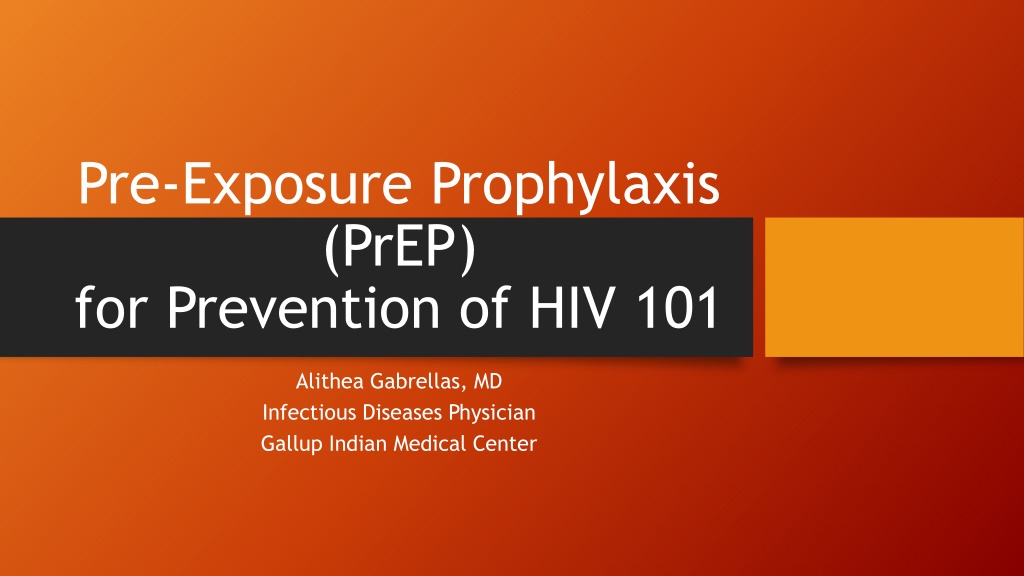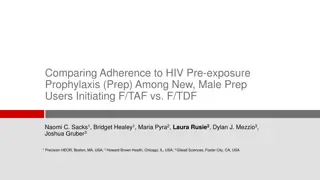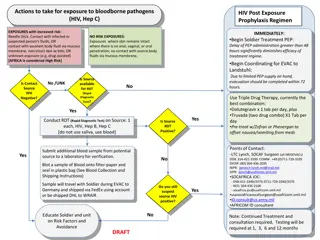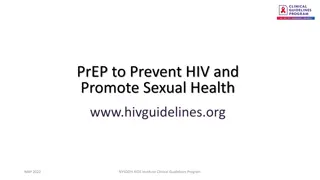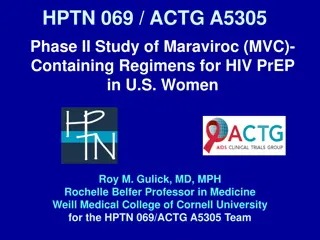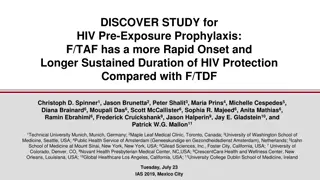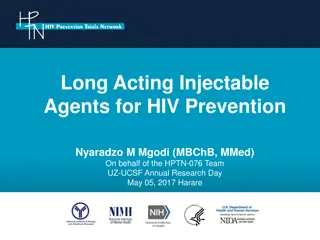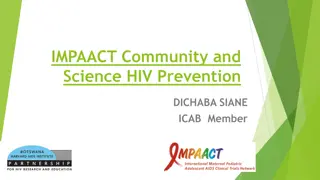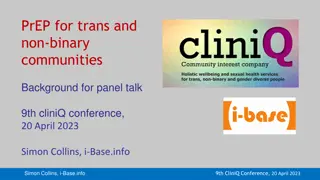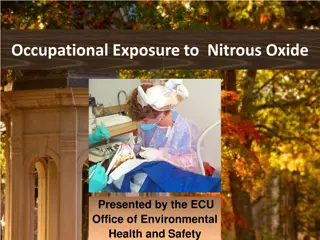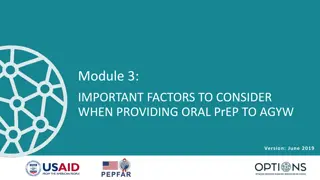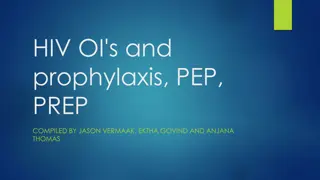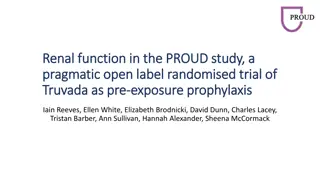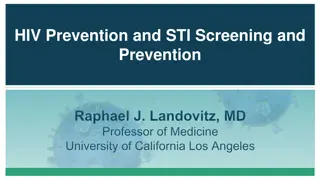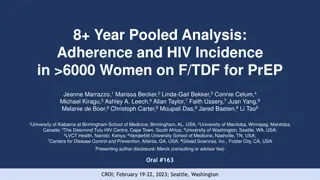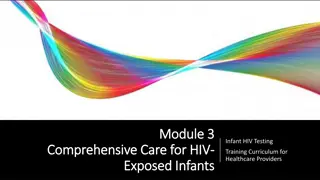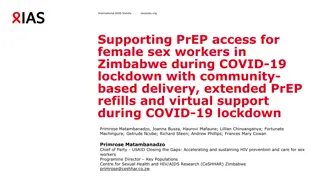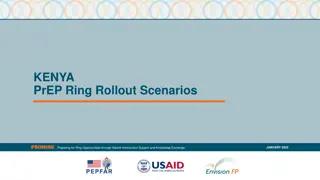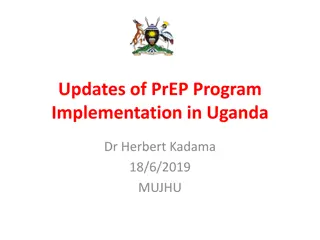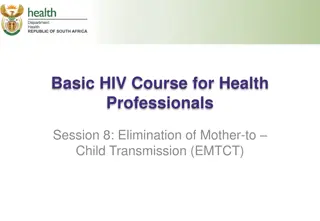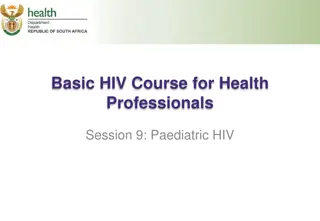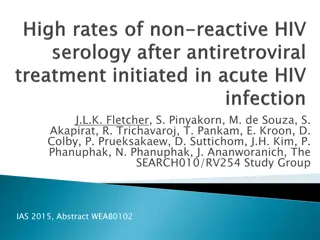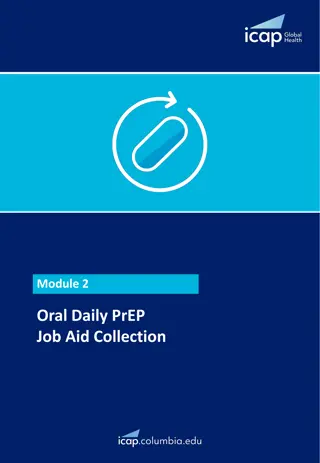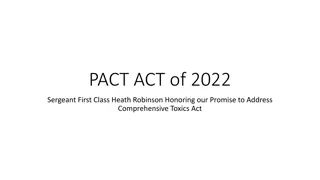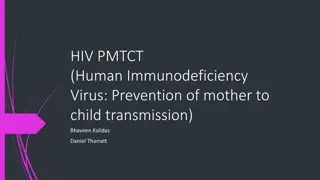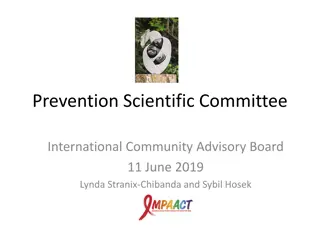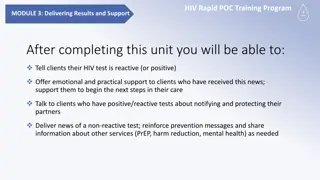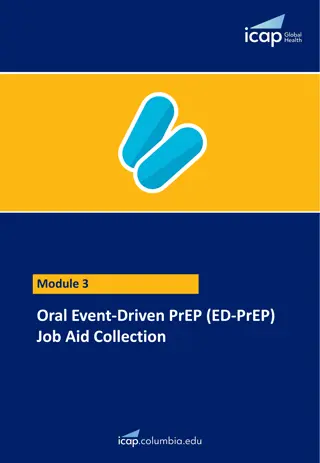Comprehensive Guide to Pre-Exposure Prophylaxis (PrEP) for HIV Prevention
Learn about the importance of Pre-Exposure Prophylaxis (PrEP) for preventing HIV acquisition in sexually active individuals, including the need for HIV testing, indications for PrEP, and identifying acute HIV infection. This guide emphasizes the significance of offering PrEP to all at-risk individuals, regardless of disclosed risk behaviors, and highlights the essential role of healthcare providers in ensuring safe and effective PrEP use.
Uploaded on Oct 07, 2024 | 0 Views
Download Presentation

Please find below an Image/Link to download the presentation.
The content on the website is provided AS IS for your information and personal use only. It may not be sold, licensed, or shared on other websites without obtaining consent from the author. Download presentation by click this link. If you encounter any issues during the download, it is possible that the publisher has removed the file from their server.
E N D
Presentation Transcript
Pre-Exposure Prophylaxis (PrEP) for Prevention of HIV 101 Alithea Gabrellas, MD Infectious Diseases Physician Gallup Indian Medical Center
Identifying Indications for PrEP All sexually active adults and adolescents should be informed about PrEP for prevention of HIV acquisition Studies have shown that patients often do not disclose stigmatized sexual or substance use behaviors to their health care providers (especially when not asked about specific behaviors) Patients may request PrEP because of concern about acquiring HIV but not feel comfortable reporting sexual or injection behaviors to avoid anticipated stigmatizing responses in health care settings. For this reason, after attempts to assess patient sexual and injection behaviors, patients who request PrEP should be offered it, even when no specific risk behaviors are elicited
HIV Testing HIV testing with confirmed results from within the past 7 days is required to document that patients do not have HIV when they start or re-start taking PrEP medications The required HIV testing before initiation can be accomplished by drawing blood (serum) and sending the specimen to a laboratory for an antigen/antibody test or performing a rapid, point-of-care, FDA-approved, fingerstick antigen/antibody blood test In the context of PrEP, rapid tests that use oral fluid should not be used to screen for HIV infection because they are less sensitive for the detection of acute or recent infection than blood tests
Acute HIV Infection Clinicians should suspect acute HIV infection in persons who report having engaged in exposure-prone behaviors in the 4 weeks prior to evaluation for PrEP (e.g., a condom broke during sex with an HIV-infected partner, relapse to injection drug use with shared injection equipment) For all PrEP candidates with a negative or an indeterminate result on an HIV antigen/antibody who report a recent possible HIV exposure event, clinicians should next solicit a history of signs or symptoms of viral infection during the preceding month
HIV Testing While HIV-1 RNA testing is sensitive, healthcare providers should be aware that available assays might yield false-positive low viral load results (e.g., <200 copies/mL) Without confirmatory tests, such false-positive results can lead to misdiagnosis of HIV infection When clinicians prescribe PrEP based solely on the results of point of care rapid tests, a laboratory antigen/antibody test should always be ordered at the time baseline labs are drawn. This will increase the likelihood of detecting unrecognized acute infection so that the patient can be transitioned from PrEP to antiretroviral treatment in a timely manner
Testing for Sexually Transmitted Infections Tests to screen for syphilis are recommended for all adults prescribed PrEP, both at screening and at semi-annual visits Tests to screen for gonorrhea and chlamydia are recommended for all sexually active adults prescribed PrEP, both at screening, for MSM at quarterly visits, and for cis-gender women at semi-annual visits (gonorrhea) and every 12 months (chlamydia) For MSM, gonorrhea and chlamydia screening using NAAT tests are preferred because of their sensitivity. Pharyngeal, rectal, and urine specimens should be collected ( 3-site testing ) to maximize the identification of infection. Patient self-collected samples have equivalent performance as clinician-obtained samples and can help streamline patient visit flow
Renal Function In addition to confirming that any patient starting PrEP medication is not infected with HIV, a clinician must assess renal function because decreased renal function is a potential safety issue for the use of F/TDF or F/TAF as PrEP For all persons considered for PrEP with either F/TDF or F/TAF, a serum creatinine test should be done, and an eCrCL should be calculated by using the Cockcroft-Gault formula. Any person with an eCrCl of 60 ml/min can safely be prescribed PrEP with F/TDF. PrEP with F/TAF can be safely prescribed for persons with eCrCl >30
Testing for Infection with Hepatitis B Virus (HBV) Tenofovir and emtricitabine are also used to treat chronic HBV infection. When these drugs are discontinued, patients with HBV infection may experience clinically significant hepatitis flares. Prior to prescribing PrEP, patients should be screened for HBV so that in the event they have HBV infection, they can be informed of the danger of stopping PrEP medication without appropriate monitoring for potential hepatitis flares. However, PrEP initiation should not be withheld while waiting for HBV test results. Patients who are not immune and do not have HBV infection should be vaccinated. Providers prescribing F/TDF or F/TAF as PrEP for patients who have HBV infection (either known or first diagnosed as part of a PrEP evaluation) should do so in consultation with a provider expert in HBV treatment.
Lipid Profile In the DISCOVER clinical trial comparing F/TDF and F/TAF for PrEP in MSM and transgender women, higher rates of triglyceride elevation and of weight gain were seen among men taking F/TAF than among men taking F/TDF This may indicate a longer-term safety risk when prescribing F/TAF PrEP for men with pre-existing cardiovascular health risk factors (e.g., obesity, age, lipid profiles) Persons prescribed F/TAF for PrEP should have monitoring of triglyceride and cholesterol levels every 12 months
Testing Not Indicated for Oral PrEP In clinical trials for PrEP with F/TDF or F/TAF, additional testing was done to evaluate safety Findings in those trials indicated that DEXA scans to monitor bone mineral density, liver function tests, hematologic assays, and urinalysis are not indicated for the routine care of all persons prescribed daily oral PrEP
Prescribing Oral PrEP The fixed-dose combination of F/TDF in a single daily dose is approved by FDA for PrEP in healthy adults and adolescents at risk of acquiring HIV F/TDF continues to be most commonly prescribed for PrEP (including PWID) who meet criteria for PrEP use F/TDF is available as a generic medication that is equivalent to the brand name medication
Prescribing Oral PrEP F/TAF is approved for daily PrEP use by men and transgender women at sexual risk F/TAF is not approved for PrEP use by women at risk through receptive vaginal sex for whom F/TDF should be prescribed instead F/TAF and F/TDF have equivalent high efficacy and safety as PrEP for men at sexual risk Generic F/TAF is not available
Managing Side Effects of Oral PrEP Patients taking PrEP should be informed of potential side effects. Some (<10%) of patients prescribed F/TDF or F/TAF experience a start-up syndrome that usually resolves within the first month of taking PrEP medication. This may include headache, nausea, or abdominal discomfort. OTC medications can help. Patients should also be counseled about signs or symptoms that indicate a need for urgent evaluation when they occur between scheduled follow-up visits (e.g., those suggesting possible acute renal injury or acute HIV infection) Weight gain is a reported side effect of F/TAF for PrEP
Follow-up PrEP Care Visits for Oral PrEP All patients receiving oral PrEP should be seen in follow-up at least every 3 months to: Repeat HIV testing and assess for signs or symptoms of acute infection to document that patients are still HIV negative Provide a prescription or refill authorization of daily PrEP medication for no more than 90 days (until the next HIV test) Assess and provide support for medication adherence and risk-reduction behaviors Conduct STI and other recommended testing
Non-Daily Oral PrEP Regimens for MSM The 2-1-1 regimen (also called event-driven, intermittent, or on-demand ) is a nondaily PrEP regimen that times oral F/TDF doses in relation to sexual intercourse events While not an FDA approved regimen, two clinical trials, IPERGAY and the subsequent Pr venir open label study in Paris have demonstrated the HIV prevention efficacy of 2-1-1 dosing only with F/TDF and only for MSM
Non-Daily Oral PrEP Regimens for MSM This not an FDA approved regimen and not commonly used in the IHS, but based on trial experience, MSM who are using the 2-1-1 regimen should be counseled to take F/TDF as follows: 2 pills in the 2-24 hours before sex (closer to 24 hours preferred) 1 pill 24 hours after the initial two-pill dose 1 pill 48 hours after the initial two-pill dose
Non-Daily Oral PrEP Regimens for MSM Based on the timing of subsequent sexual events, MSM should be instructed to take additional doses as follows: If sex occurs on the consecutive day after completing the 2-1-1 doses, take 1 pill per day until 48 hours after the last sexual event. If a gap of <7 days occurs between the last pill and the next sexual event, resume 1 pill daily If a gap of 7 days or more occurs between the last pill and next sexual event, start again with 2 pills
Non-Daily Oral PrEP Regimens for MSM The only U.S. data concerning nondaily dosing among MSM came from the ADAPT HPTN 067 study participants in Harlem, New York Investigators estimated PrEP effectiveness among those MSM prescribed a time-driven regimen (two doses per week 3-4 days apart) or an event-driven regimen (one pill taken before and another after sex) compared to MSM who were prescribed daily dosing When assessing PrEP coverage of reported sex acts, predicted effectiveness was significantly lower for the two nondaily dosing patterns (62% and 68%, respectively) compared to daily dosing (80%)
Cabotegravir PrEP Injections Cabotegravir injections may be especially appropriate for patients with significant renal disease, those who have had difficulty with adherent use of oral PrEP and those who prefer injections every 2 months to an oral PrEP dosing schedule 600 mg of cabotegravir injected into gluteal muscle every 2 months is recommended for PrEP in adults at risk of acquiring HIV 30 mg daily oral cabotegravir is optional for a 4-week lead-in prior to injections
Laboratory Testing for CAB-PrEP Patients Patients whose HIV test results indicate that they do not have acute or chronic HIV infection can be considered for initiation of cabotegravir injections Because of the long duration of drug exposure following injection, exclusion of acute HIV infection is necessary with the most sensitive test available, an HIV-1 RNA assay Ideally, this testing will be done within 1 week prior to the initiation visit. If clinicians wish to provide the first injection at the first PrEP evaluation visit based on the result of a rapid combined antigen/antibody assay, blood should always be drawn for laboratory confirmatory testing that includes an HIV RNA assay
Laboratory Testing for CAB-PrEP Patients Based on the results of the CAB clinical trials the following laboratory tests are NOT indicated before starting CAB injection or for monitoring patients during its use: Creatinine, eCrCl Hepatitis B serologies Lipid panels Liver function tests
Managing Injection Site Reactions In the clinical trials, injection site reactions (pain, tenderness, induration) were frequent following CAB injections. These reactions were generally mild or moderate, lasted only a few days, and occurred most frequently after the first 2-3 injections For the first 2-3 injections patients may want to take an over-the- counter pain medication within a couple of hours before or soon after the injection and continue as needed for one to two days Apply a warm compress or heating pad to the injection site for 15-20 minutes after the injection (e.g., after arriving back at home)
Clinical Follow-up and Monitoring for CAB Once CAB injections are initiated, patients should return for follow-up visits 1 month after the initial injection and then every 2 months At visit 1 month after initial injection (month 1, second injection), repeat HIV-1 RNA test and assess for signs or symptoms of acute infection, administer CAB injection and respond to new questions At each bimonthly visit (beginning with the third injection month 3), repeat HIV-1 RNA test and assess for signs or symptoms of acute infection and administer CAB injection
Considerations for HIV Testing in PrEP Recent data have shown that the performance of HIV tests in persons who acquire HIV infection while taking antiretroviral medications for PrEP differs from test performance in persons not exposed to antiretrovirals at or after the time of HIV acquisition The antiretrovirals used for PrEP can suppress early viral replication which can affect the timing of antibody development In HPTN 083, detection among participants in the cabotegravir group with antigen/antibody testing was delayed by a mean of 62 days compared to detection by qualitative HIV-1 RNA assay for infections determined to have been present at baseline; the delay was 98 days for incident infections. Among participants in the F/TDF group, detection by antigen/antibody testing was delayed by a mean of 34 days from qualitative HIV-1 RNA detection for baseline infections and 31 days for incident infections
References 1. Grohskopf LA, Chillag KL, Gvetadze R, et al. Randomized trial of clinical safety of daily oral tenofovir disoproxil fumarate (TDF) among HIV-uninfected men who have sex with men (MSM) in the United States. J Acquir Immune Defic Syndr. 2013; 64(1):79-86. 2. Grant RM, Lama JR, Anderson PL, et al. Preexposure chemoprophylaxis for HIV prevention in men who have sex with men. N Engl J Med. 2010;363(27):2587-99. doi:10.1056/NEJMoa1011205 3.Mayer KH, Molina J-M, Thompson MA, et al. Emtricitabine and tenofovir alafenamide vs emtricitabine and tenofovir disoproxil fumarate for HIV pre-exposure prophylaxis (DISCOVER):primary results from a multicentre, active-controlled, phase 3, noninferiority trial. The Lancet. 2020;396(10246):239-254. 4. HIV Prevention Trials Network. HPTN 084 Study Demonstrates superiority of CAB LA to oral FTC/TDF for the prevention of HIV. 2020 5. Landovitz RJ, Donnell D, Clement ME, et al. Cabotegravir for HIV prevention in cisgender men and transgender women. N Engl J Med. 2021;385(7):595-608 6. Preexposure Prophylaxis for the Prevention of HIV Infection in the United States 2021 Update Clinical Practice Guideline
